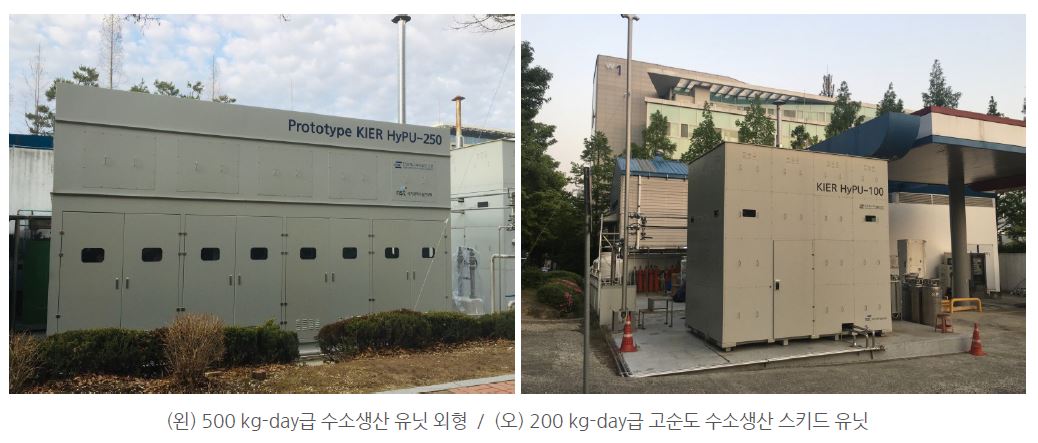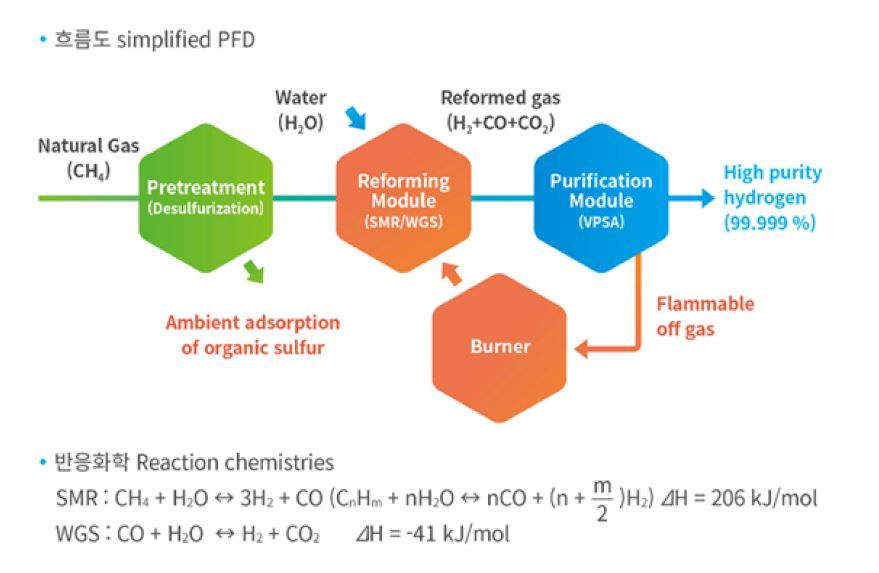KIER STORY
- Date
- 2022-03-21
- Views
- 9,030
Development of High-Efficiency Hydrogen Production Source Technology for Economic Knowledge
1 billion won / less than 1 unit for hydrogen charging stations
Amid the government's recent efforts to foster new industries through regulatory improvements such as four rounds of "regulatory innovation measures for new industries" and a "roadmap for preemptive regulatory innovation for eco-friendly vehicles" such as hydrogen cars and electric vehicles, "high-efficiency hydrogen production source technology" has been developed by domestic researchers.
Dr. Yoon Wang-rae, a researcher at the Korea Institute of Energy Technology (President Kim Jong-nam), succeeded in localizing 100% of the original design and engineering technology of the "On-Site High-Purity Hydrogen Production Unit" that can produce and supply 99.999% of high-purity hydrogen in urban areas or near demand sources. The localization rate of the core technology of the "field-produced natural gas-reformed high-purity hydrogen production unit," a key element of hydrogen infrastructure construction, is only 40 to 50%. This is because there are no local products that are practically commercially available and have proven performance, so they rely entirely on imports. As a result, initial facility investment costs 3 billion won per unit, and in order to secure the cost-effectiveness of the hydrogen price of 6,000 won/kg, the target of the "Hydrogen Economy Revitalization Roadmap" in 2022, the localization rate must be raised to be less than 1 billion won per unit and 80% hydrogen production efficiency.
(left) 500kg-day hydrogen production unit appearance / (right) 200kg-day high purity hydrogen production skid unit
Field-produced high-purity hydrogen production technology is an early core infrastructure for hydrogen economy transition, consisting of reforming modules that extract hydrogen from each reactant by reacting natural gas and water vapor and purification modules (VPSA). It is important to design a heat and material transfer reactor (SMR) that has the most important effect on system efficiency. To this end, a heat exchange integrated convective heat transfer reformer is designed and a heat exchange automatic heat exchange gas transition reactor is designed.
SMR(steam Methane Reformaing) : The steam methane extraction method is a method of extracting hydrogen by catalyzing methane (natural gas) and water at a high temperature of 700°C or higher as fuel.
In addition, VPSA (vacuum pressure fluctuation adsorption) was developed instead of the existing PSA for high purity hydrogen purification, and the effective adsorption amount and separation efficiency were maximized through optimal layering and arrangement of five adsorbents. Through this, it was designed to maintain hydrogen purification efficiency above 99.999% and CO concentration below 0.2 ppm. The field-produced high-purity hydrogen production unit technology recorded a high efficiency of 81%, exceeding 75-80% of the initial hydrogen energy supply specifications proposed by the U.S. Department of Energy and NEDO in Japan, and showed sufficient competitiveness in that it can easily and stably supply hydrogen without additional infrastructure investment.
Dr. Yoon Wang-rae of the hydrogen research team, the research manager, said, "This technology is expected to play a very important role as a key source of the early hydrogen economy transition along with by-product hydrogen." He also stressed, "As a prerequisite for voluntary market entry, reliable quality data related to system performance, such as efficiency of 80% or more, CO (carbon monoxide) concentration of 0.2 ppm or less, and stable operation, should be secured." This research and development has been conducted for four years since 2017 as part of a BIG research project supported by the National Science and Technology Research Association, and on Monday, May 18, the Korea Institute of Energy and Technology signed a technology transfer contract worth 5 billion won.
Meanwhile, Wonil TNI Co., Ltd. plans to actively respond to the government's distributed small hydrogen production base construction project with the "field-produced high-purity hydrogen production unit" technology transferred from the Korea Energy Research Institute.



